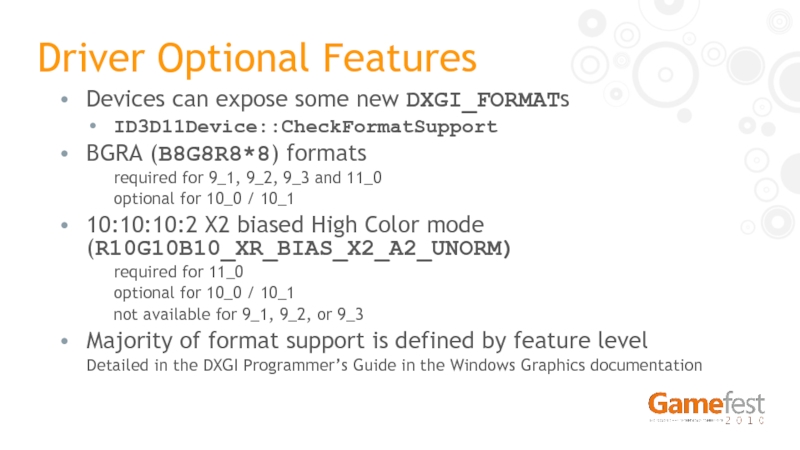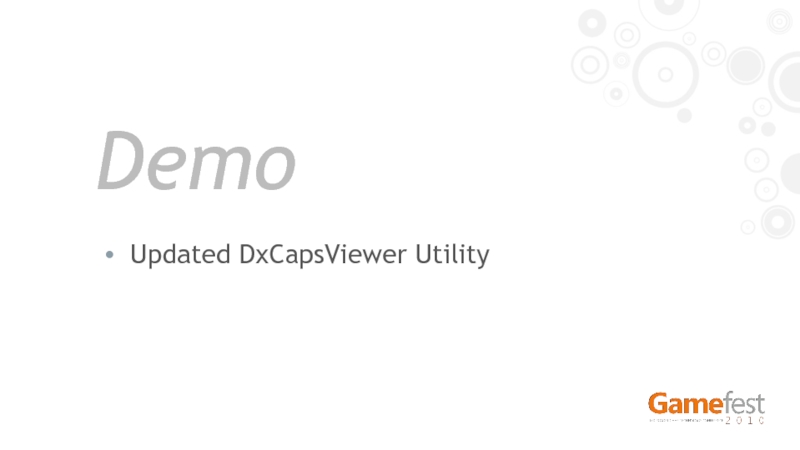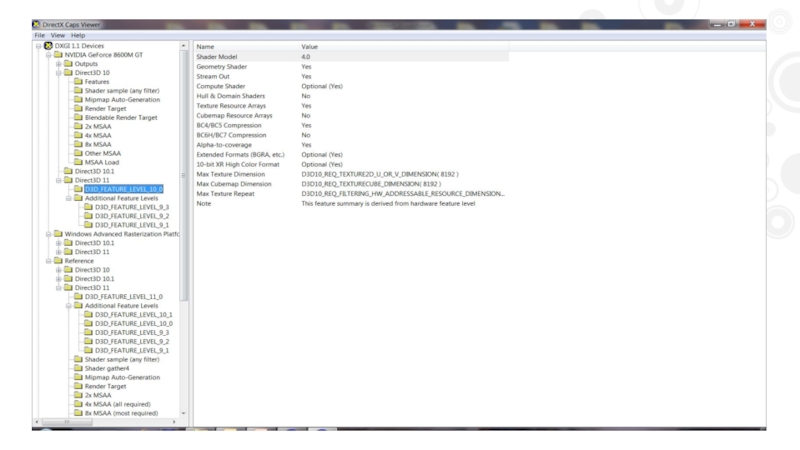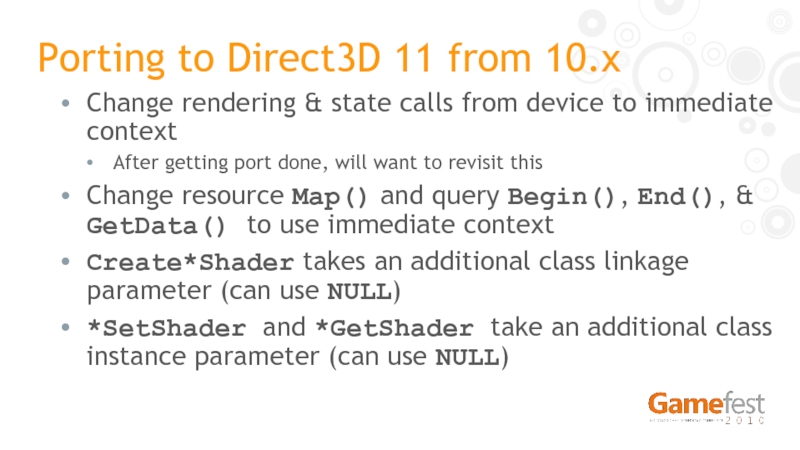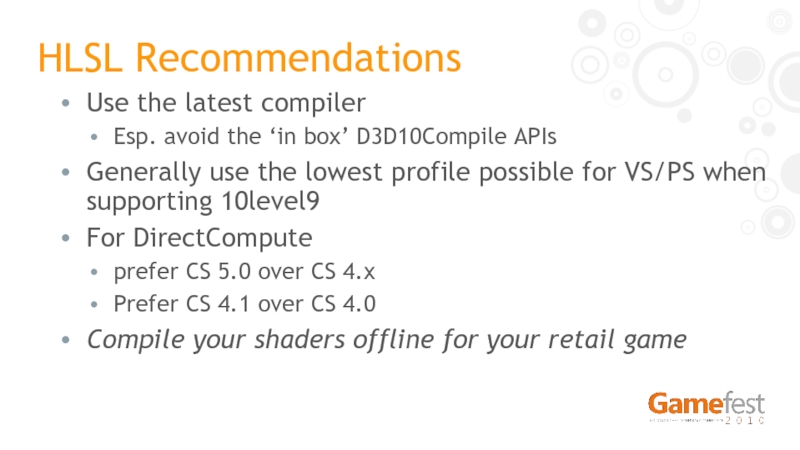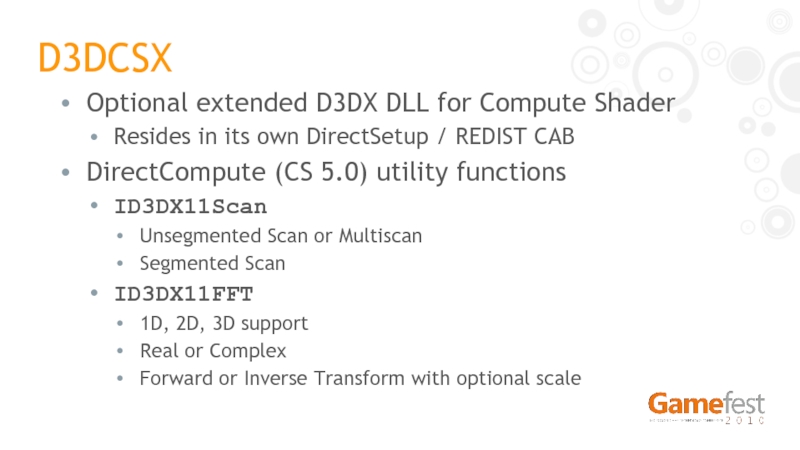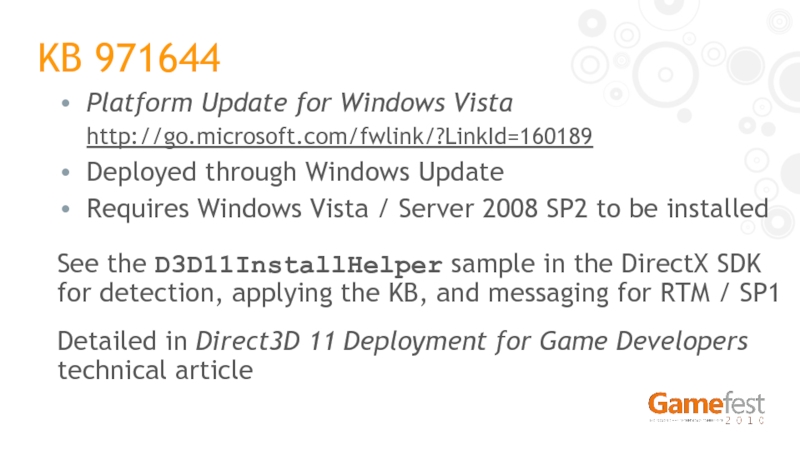- Главная
- Разное
- Дизайн
- Бизнес и предпринимательство
- Аналитика
- Образование
- Развлечения
- Красота и здоровье
- Финансы
- Государство
- Путешествия
- Спорт
- Недвижимость
- Армия
- Графика
- Культурология
- Еда и кулинария
- Лингвистика
- Английский язык
- Астрономия
- Алгебра
- Биология
- География
- Детские презентации
- Информатика
- История
- Литература
- Маркетинг
- Математика
- Медицина
- Менеджмент
- Музыка
- МХК
- Немецкий язык
- ОБЖ
- Обществознание
- Окружающий мир
- Педагогика
- Русский язык
- Технология
- Физика
- Философия
- Химия
- Шаблоны, картинки для презентаций
- Экология
- Экономика
- Юриспруденция
Directx 11. Technology update презентация
Содержание
- 2. DirectX 11 Technology Update Chuck Walbourn Senior Software Design Engineer Microsoft
- 3. Gamefest 2008 Graphics Track Introduction to the
- 4. DirectX 11 Overview Direct3D 11 is based
- 6. Features & Feature Levels Feature levels are
- 8. DirectX 11 Feature Levels
- 9. 10level9 Feature Levels
- 10. Driver Optional Features Devices can expose some
- 11. Driver Optional Features DirectX 11 drivers can
- 12. Related Technologies
- 13. Updated DxCapsViewer Utility Demo
- 15. ID3D10Device ID3D10DeviceChild ID3D10VertexShader ID3D10GeometryShader ID3D10PixelShader ID3D10InputLayout ID3D10DepthStencilState
- 16. ID3D10Device1 ID3D10DeviceChild ID3D10VertexShader ID3D10GeometryShader ID3D10PixelShader ID3D10InputLayout ID3D10DepthStencilState
- 17. ID3D11Device ID3D11DeviceChild ID3D11VertexShader ID3D11GeometryShader ID3D11PixelShader ID3D11InputLayout ID3D11DepthStencilState
- 18. ID3D11Device ID3D11DeviceChild ID3D11Asynchronous ID3D11Resource ID3D11View ID3D11Query ID3D11Predicate
- 19. Direct3D 11 API Change Main difference is
- 20. ID3D11Device is thread-safe Without driver support for
- 21. ID3D11DeviceContext is not thread-safe Typical usage is
- 22. ID3D11DeviceContext deferred mode limitations Map() must be
- 23. Concurrent creation is a no brainer Many
- 24. Concurrent submission depends on the scenario Useful
- 25. Porting to Direct3D 11 from 10.x Start
- 26. Porting to Direct3D 11 from 10.x Change
- 27. Some defines changed, so be sure you
- 28. Porting to Direct3D 11 from 9 Essentially
- 29. Porting to Direct3D 11 from 9 Start
- 30. HLSL Compiler DirectX 11 requires 4.0 or
- 31. Shader profiles in DirectX 11 can be
- 32. Use the latest compiler Esp. avoid the
- 33. Effects (FX) Library Effects for Direct3D 11
- 34. D3DX11 Includes texture loaders (BMP, JPG, PNG,
- 35. D3DCSX Optional extended D3DX DLL for Compute
- 36. XNAMath aka xboxmath 2.0 Inline C++ SSE/SSE2
- 37. DirectX 11 Deployment DirectX 11 Runtime is
- 38. DirectX 11 Runtime
- 39. KB 971644 Platform Update for Windows Vista
- 40. For corporate network environments using Windows Server
- 41. Update your existing Direct3D 10.x code path
- 42. If you still only have a legacy
- 43. Latest DirectX SDK http://msdn.microsoft.com/directx Gamefest 2008 Graphics
- 44. APPENDIX
- 45. #include “d3d10.h” IDXGISwapChain *g_pSwapChain = NULL; ID3D10Device
- 46. #include “d3d10_1.h” IDXGISwapChain *g_pSwapChain = NULL; ID3D10Device1
- 47. #include “d3d11.h” IDXGISwapChain *g_pSwapChain = NULL; ID3D11Device
- 48. #include “d3d11.h” IDXGISwapChain *g_pSwapChain = NULL; ID3D11Device
- 49. #include “d3d11.h” IDXGISwapChain *g_pSwapChain = NULL; ID3D11Device
- 50. DirectX 11 Debugging DirectX SDK provides debugging
- 51. DirectX 11 Debugging Make sure your application
- 52. Debug layer messages in debug window use
- 53. Windows 7 / Server 2008 R2 only
Слайд 3Gamefest 2008
Graphics Track
Introduction to the Direct3D 11 Graphics Pipeline
Direct3D 11 Tessellation
High
Multithreaded Rendering for Games
Direct3D 11 Compute Shader—More Generality for Advanced Techniques
Partners Track
Advanced Topics in GPU Tessellation (AMD)
Water-Tight, Textured, Displaced Subdivision Surface Tessellation Using Direct3D 11 (NVIDIA)
Слайд 4DirectX 11 Overview
Direct3D 11 is based on Direct3D 10.1
Similar API design
Enables new DirectX 11 hardware features
Supports existing DirectX 10 and 10.1 hardware
Enables some new features as well
Supports a subset of DirectX 9 SM 2.0+ hardware
Supported on Windows 7, Windows Vista, Windows Server 2008, and Windows Server 2008 R2
Input Assembler
Vertex Shader
Pixel Shader
Hull Shader
Rasterizer
Output Merger
Tessellator
Domain Shader
Geometry Shader
Stream Output
Слайд 6Features & Feature Levels
Feature levels are well-defined sets of functionality
Not a
Each feature level is a superset of the previous one
Concept was introduced with Direct3D 10.1
ID3D10Device1::GetFeatureLevel()
D3D10_FEATURE_LEVEL_10_1
D3D10_FEATURE_LEVEL_10_0
Слайд 10Driver Optional Features
Devices can expose some new DXGI_FORMATs
ID3D11Device::CheckFormatSupport
BGRA (B8G8R8*8) formats
required for
optional for 10_0 / 10_1
10:10:10:2 X2 biased High Color mode (R10G10B10_XR_BIAS_X2_A2_UNORM)
required for 11_0
optional for 10_0 / 10_1
not available for 9_1, 9_2, or 9_3
Majority of format support is defined by feature level
Detailed in the DXGI Programmer’s Guide in the Windows Graphics documentation
Слайд 11Driver Optional Features
DirectX 11 drivers can support four optional features
ID3D11Device::CheckFeatureSupport
DirectCompute
D3D_FEATURE_LEVEL_10_0 /
CS 5.0 is required for D3D_FEATURE_LEVEL_11_0
Double-precision shader support is optional
Multithreading Driver support is optional
Concurrent object creation
Command lists
Слайд 15ID3D10Device
ID3D10DeviceChild
ID3D10VertexShader
ID3D10GeometryShader
ID3D10PixelShader
ID3D10InputLayout
ID3D10DepthStencilState
ID3D10BlendState
ID3D10RasterizerState
ID3D10SamplerState
ID3D10Asynchronous
ID3D10Query
ID3D10Predicate
ID3D10Counter
ID3D10Resource
ID3D10Buffer
ID3D10Texture1D
ID3D10Texture2D
ID3D10Texture3D
ID3D10View
ID3D10ShaderResourceView
ID3D10RenderTargetView
ID3D10DepthStencilView
Direct3D 10.0 API
Слайд 16ID3D10Device1
ID3D10DeviceChild
ID3D10VertexShader
ID3D10GeometryShader
ID3D10PixelShader
ID3D10InputLayout
ID3D10DepthStencilState
ID3D10BlendState1
ID3D10RasterizerState
ID3D10SamplerState
ID3D10Asynchronous
ID3D10Query
ID3D10Predicate
ID3D10Counter
ID3D10Resource
ID3D10Buffer
ID3D10Texture1D
ID3D10Texture2D
ID3D10Texture3D
ID3D10View
ID3D10ShaderResourceView1
ID3D10RenderTargetView
ID3D10DepthStencilView
Direct3D 10.1 API
Слайд 17ID3D11Device
ID3D11DeviceChild
ID3D11VertexShader
ID3D11GeometryShader
ID3D11PixelShader
ID3D11InputLayout
ID3D11DepthStencilState
ID3D11BlendState
ID3D11RasterizerState
ID3D11SamplerState
ID3D11Asynchronous
ID3D11Query
ID3D11Predicate
ID3D11Counter
ID3D11Resource
ID3D11Buffer
ID3D11Texture1D
ID3D11Texture2D
ID3D11Texture3D
ID3D11View
ID3D11ShaderResourceView
ID3D11RenderTargetView
ID3D11DepthStencilView
Direct3D 11 API (partial)
Слайд 18ID3D11Device
ID3D11DeviceChild
ID3D11Asynchronous
ID3D11Resource
ID3D11View
ID3D11Query
ID3D11Predicate
ID3D11Counter
ID3D11VertexShader
ID3D11GeometryShader
ID3D11PixelShader
ID3D11ComputeShader
ID3D11HullShader
ID3D11InputLayout
ID3D11DepthStencilState
ID3D11BlendState
ID3D11RasterizerState
ID3D11SamplerState
ID3D11ClassInstance
ID3D11ClassLinkage
ID3D11CommandList
ID3D11Buffer
ID3D11Texture1D
ID3D11Texture2D
ID3D11Texture3D
ID3D11ShaderResourceView
ID3D11RenderTargetView
ID3D11DepthStencilView
ID3D11UnorderedAccessView
ID3D11DomainShader
ID3D11DeviceContext
Слайд 19Direct3D 11 API Change
Main difference is ID3D10Device was split in two
Object
Other methods split off into ID3D11DeviceContext interface
Rendering and state configuration
Map()/Unmap() from resource objects
Begin(), End(), and GetData() from query objects
One immediate context for rendering directly to the device
Zero or more deferred contexts for creating command lists
Provides basis of multithreading improvements
Слайд 20ID3D11Device is thread-safe
Without driver support for Concurrent Creates, runtime will enforce
Without driver support for Concurrent Creates, creating objects and rendering with the immediate context will not be concurrent (using the same coarse lock)
Methods on most other objects (ID3D11DeviceChild-derived) are also thread-safe
Can opt-out by using D3D11_CREATE_DEVICE_SINGLETHREADED
Multi-threading Rules
Слайд 21ID3D11DeviceContext is not thread-safe
Typical usage is one device context per thread,
Note that DXGI methods should not be used concurrently while rendering with the immediate device context
For example, Present() uses the immediate device context
It is thread-safe to use the methods inherited from ID3D11DeviceChild
AddRef(), Release(), QueryInterface()
GetDevice(), GetPrivateData(), SetPrivateData(), SetPrivateDataInterface()
Multi-threading Rules
Слайд 22ID3D11DeviceContext deferred mode limitations
Map() must be used with D3D11_MAP_WRITE_DISCARD and/or D3D11_MAP_WRITE_NO_OVERWRITE
GetData()
Queries can be used in conjunction with predication
If executing a deferred command list with a query active
and the command list itself uses the same query,
then the command list submission is ignored as invalid
Multi-threading Rules
Слайд 23Concurrent creation is a no brainer
Many engines already have resource loading
Runtime emulation is “good enough” for a win
Less overhead than the default Direct3D 10 M/T behavior
ConcurrentCreates driver support makes it better
When creating objects with M/T driver support, providing initial data for static objects should be more efficient
i.e Use the pInitialData parameter on the Create rather than staging resources, UpdateSubResource(), or Map() when possible
Multi-threading Recommendations
Слайд 24Concurrent submission depends on the scenario
Useful for Triple-core, Quad-core, or more
For
Best use scenario is one rendering thread per core
Ideally use the Windows Vista/Windows 7 thread pool API
If you roll your own solution, see the DirectX SDK CoreDetection sample for the robust way to determine number of cores
Similar but not identical to Xbox 360 Command Buffers
Driver CommandLists support is currently rare
Multi-threading Recommendations
Слайд 25Porting to Direct3D 11 from 10.x
Start with a simple text translation
ID3D10*
D3D10_* -> D3D11_*
If starting with Direct3D 10.0, will need to fix up a few minor structure differences
(11 matches the 10.1 version)
D3D10_BLEND_DESC1
D3D10_SHADER_RESOURCE_VIEW_DESC1
Слайд 26Porting to Direct3D 11 from 10.x
Change rendering & state calls from
After getting port done, will want to revisit this
Change resource Map() and query Begin(), End(), & GetData() to use immediate context
Create*Shader takes an additional class linkage parameter (can use NULL)
*SetShader and *GetShader take an additional class instance parameter (can use NULL)
Слайд 27Some defines changed, so be sure you aren’t using magic numbers
A minor feature was completely dropped
ID3D10Device::GetTextFilterSize
ID3D10Device::SetTextFilterSize
D3D10_FILTER_TEXT_1BIT
Vendor-neutral performance counters removed
Were rarely implemented or consistent
i.e. D3D11_COUNTER_DEVICE_DEPENDENT_0 is the only counter enumeration
Porting to Direct3D 11 from 10.x
Слайд 28Porting to Direct3D 11 from 9
Essentially the same as porting from
Remove all fixed-function pipeline usage
Use state management based on immutable state objects
Obey strict shader linkage and input layout rules
Use shader resource views associated with texture resources
Map data to DXGI_FORMATs (no 16-bit formats, no 24-bit color format, strict RGB color order)
Rework global constant data into several constant buffers for efficient update
Слайд 29Porting to Direct3D 11 from 9
Start with the existing guidance for
SIGGRAPH 2007 Course #5
Introduction to Direct3D 10
http://msdn.microsoft.com/directx/presentations
Gamefest 2007 talk
“Windows to Reality: Getting the Most out of Direct3D 10 Graphics in Your Games”
http://www.microsoftgamefest.com/presentations/2007.htm
Слайд 30HLSL Compiler
DirectX 11 requires 4.0 or later profile shaders
D3DCompile DLL contains
Used by D3DX9, D3DX10, D3DX11, and FXC.EXE
Can use directly (i.e. without using D3DX)
Note it is in its own DirectSetup CAB file in the REDIST folder
Supports all shader models except Pixel Shader 1.x profiles
Слайд 31Shader profiles in DirectX 11 can be applied to higher feature
10level9 shader profiles are compiled twice internally
vs_4_0_level_9_* => vs_2_0 + vs_4_0
ps_4_0_level_9_1 => ps_2_0 + ps_4_0
ps_4_0_level_9_3 => ps_2_b + ps_4_0
Shader Profiles and Feature Levels
Слайд 32Use the latest compiler
Esp. avoid the ‘in box’ D3D10Compile APIs
Generally use
For DirectCompute
prefer CS 5.0 over CS 4.x
Prefer CS 4.1 over CS 4.0
Compile your shaders offline for your retail game
HLSL Recommendations
Слайд 33Effects (FX) Library
Effects for Direct3D 11 (FX11) is shared source in
FX9 was in D3DX9
FX10 was in box with the OS
Porting from FX10 -> FX11 is fairly trivial
Essentially the same API without effects pools
Porting from FX9 -> FX11 requires significant code change
Слайд 34D3DX11
Includes texture loaders (BMP, JPG, PNG, DDS, TIFF, GIF)
and asynchronous loaders
Does not include D3DX Math, Mesh, Sprite, or Font
See XNAMath as alternative for D3DX Math
and DXUT11 for alternative to font, etc.
D3DX11 uses a CPU codec for BC6H/BC7 texture compression, which can be time-consuming.
For a fast DirectCompute 4.x solution, see the BC6HBC7EncoderDecoder11 sample.
Слайд 35D3DCSX
Optional extended D3DX DLL for Compute Shader
Resides in its own DirectSetup
DirectCompute (CS 5.0) utility functions
ID3DX11Scan
Unsegmented Scan or Multiscan
Segmented Scan
ID3DX11FFT
1D, 2D, 3D support
Real or Complex
Forward or Inverse Transform with optional scale
Слайд 36XNAMath
aka xboxmath 2.0
Inline C++ SSE/SSE2 optimized math library
VMX128 optimized on Xbox
~350
Focused on single-precision floating-point operations
Limited integer operations
Conversion to/from packed graphics formats
Implemented using Visual Studio intrinsics
Supports x86 and x64 native
Common 3D primitives
Vectors, matrices, planes, quaternions, etc.
Слайд 37DirectX 11 Deployment
DirectX 11 Runtime is included with Windows 7 and
DirectX 11 Runtime can be deployed down-level to Windows Vista / Server 2008
D3DX11, D3DCSX, D3DCompile, etc. installed by DirectSetup / DX SDK REDIST
Just like D3DX9, D3DX10, XAUDIO2, etc.
The DirectX SDK does not install the DirectX 11 Runtime
The DX SDK does install the debug layers and reference device
Слайд 39KB 971644
Platform Update for Windows Vista
http://go.microsoft.com/fwlink/?LinkId=160189
Deployed through Windows Update
Requires Windows Vista
See the D3D11InstallHelper sample in the DirectX SDK for detection, applying the KB, and messaging for RTM / SP1
Detailed in Direct3D 11 Deployment for Game Developers technical article
Слайд 40For corporate network environments using Windows Server Update Servers (WSUS), KB
Use this update instead
Windows Graphics, Imaging, and XPS Library
http://support.microsoft.com/kb/971512/
Local IT admin will need to approve the update through the managed WSUS servers
Requires Windows Vista / Server 2008 SP2 to be installed
KB 971512
Слайд 41Update your existing Direct3D 10.x code path to use Direct3D 11
This
Your DX11 code path will require Windows Vista SP2+ or Windows 7
For Windows Vista / Windows 7 titles
10level9 feature levels can provide more hardware support, so you don’t need a Direct3D9 code path
For titles that need Windows XP support,
you will need a legacy Direct3D9 code path
Recommendations
Слайд 42If you still only have a legacy Direct3D 9 code path
Now’s
Take advantage of the existing resources
Lessons learned moving from D3D9 -> D3D10 all apply to moving from D3D9 -> D3D11
Direct3D 11 provides
the latest hardware features
new features for existing 10.x hardware
and supports the majority of video cards with WDDM drivers
Recommendations
Слайд 43Latest DirectX SDK
http://msdn.microsoft.com/directx
Gamefest 2008 Graphics and Partners Tracks
http://www.microsoftgamefest.com/presentations/2008.htm
Gamefest 2010 Graphics
“Think DirectX11 Tessellation! – what are your options?”
“DirectX 11 DirectCompute – A Teraflop for Everyone”
“Block Compression Smorgasbord”
and additional talks from AMD & NVIDIA
Resources
Слайд 45#include “d3d10.h”
IDXGISwapChain *g_pSwapChain = NULL;
ID3D10Device *g_pDevice = NULL;
…
DXGI_SWAP_CHAIN_DESC sd;
// Set to
…
HRESULT res = D3D10CreateDeviceAndSwapChain( NULL, D3D10_DRIVER_TYPE_HARDWARE,
NULL, 0, D3D10_SDK_VERSION, &sd,
&g_pSwapChain, &g_pDevice );
if ( FAILED(res) ) // Error Handling
// Bind render target from swap chain
// Set up viewport
…
Слайд 46#include “d3d10_1.h”
IDXGISwapChain *g_pSwapChain = NULL;
ID3D10Device1 *g_pDevice = NULL;
…
DXGI_SWAP_CHAIN_DESC sd;
// Set to
…
HRESULT res = D3D10CreateDeviceAndSwapChain1( NULL, D3D10_DRIVER_TYPE_HARDWARE,
NULL, 0, D3D10_FEATURE_LEVEL_10_1, D3D10_1_SDK_VERSION, &sd,
&g_pSwapChain, &g_pDevice );
if ( FAILED(res) ) {
res = D3D10CreateDeviceAndSwapChain1( NULL, D3D10_DRIVER_TYPE_HARDWARE,
NULL, 0, D3D10_FEATURE_LEVEL_10_0, D3D10_1_SDK_VERSION, &sd,
&g_pSwapChain, &g_pDevice );
}
if ( FAILED(res) ) // Error Handling
// Bind render target from swap chain
// Set up viewport
…
// use g_pDevice->GetFeatureLevel() to check for 10_1; can otherwise assume 10_0
Слайд 47#include “d3d11.h”
IDXGISwapChain *g_pSwapChain = NULL;
ID3D11Device *g_pDevice = NULL;
ID3D11DeviceContext* g_pContext = NULL;
…
DXGI_SWAP_CHAIN_DESC
// Set to desired values
…
D3D_FEATURE_LEVEL flvl[] = {
D3D_FEATURE_LEVEL_11_0, D3D_FEATURE_LEVEL_10_1, D3D_FEATURE_LEVEL 10_0 };
D3D_FEATURE_LEVEL fl;
HRESULT res = D3D11CreateDeviceAndSwapChain( NULL, D3D_DRIVER_TYPE_HARDWARE,
NULL, 0, flvl, sizeof(flvl)/sizeof(D3D_FEATURE_LEVEL),
D3D11_SDK_VERSION, &sd,
&g_pSwapChain, &g_pDevice, &fl, &g_pContext );
if ( FAILED(res) ) // Error Handling
// Bind render target from swap chain
// Set up viewport
…
// use g_pDevice->GetFeatureLevel() (or remember fl above) to check for
// 11_0 or 10_1, assume 10_0 otherwise
Слайд 48#include “d3d11.h”
IDXGISwapChain *g_pSwapChain = NULL;
ID3D11Device *g_pDevice = NULL;
ID3D11DeviceContext* g_pContext = NULL;
…
DXGI_SWAP_CHAIN_DESC
// Set to desired values
…
D3D_FEATURE_LEVEL flvl[] = {
D3D_FEATURE_LEVEL_11_0, D3D_FEATURE_LEVEL_10_1, D3D_FEATURE_LEVEL 10_0,
D3D_FEATURE_LEVEL_9_3, D3D_FEATURE_LEVEL_9_2, D3D_FEATURE_LEVEL_9_1 };
D3D_FEATURE_LEVEL fl;
HRESULT res = D3D11CreateDeviceAndSwapChain( NULL, D3D_DRIVER_TYPE_HARDWARE,
NULL, 0, flvl, sizeof(flvl)/sizeof(D3D_FEATURE_LEVEL),
D3D11_SDK_VERSION, &sd,
&g_pSwapChain, &g_pDevice, &fl, &g_pContext );
if ( FAILED(res) ) // Error Handling
// Bind render target from swap chain
// Set up viewport
…
// use g_pDevice->GetFeatureLevel() (or remember fl above) to check feature level
Слайд 49#include “d3d11.h”
IDXGISwapChain *g_pSwapChain = NULL;
ID3D11Device *g_pDevice = NULL;
ID3D11DeviceContext* g_pContext = NULL;
…
DXGI_SWAP_CHAIN_DESC
// Set to desired values
…
HRESULT res = D3D11CreateDeviceAndSwapChain( NULL, D3D_DRIVER_TYPE_HARDWARE,
NULL, 0, NULL, 0,
D3D11_SDK_VERSION, &sd,
&g_pSwapChain, &g_pDevice, NULL, &g_pContext );
if ( FAILED(res) ) // Error Handling
// Bind render target from swap chain
// Set up viewport
…
// use g_pDevice->GetFeatureLevel() to check feature level
Слайд 50DirectX 11 Debugging
DirectX SDK provides debugging layer
Enabled through code (D3D11_CREATE_DEVICE_DEBUG) or
Control panel controls the 10 and 11 debugging layer through the same settings
Unlike Direct3D 9, it is per application not a global setting
Prints messages to Windows debug output
Слайд 51DirectX 11 Debugging
Make sure your application runs ‘debug layer’ clean
ERROR and
Tools like PIX for Windows assume this level of correctness
Can also make use of the ID3D11Debug and D3D11InfoQueue interfaces
Obtain via QueryInterface from Direct3D 11 Device
Exists only if debug layer is attached
ID3D10Debug::Validate() split into ValidateContext() and ValidateContextForDispatch()
New method for DX11 Debug Layer
ID3D11Debug::ReportLiveDeviceObjects()
Слайд 52Debug layer messages in debug window use ‘friendly names’ for resources,
Can set the name by using the SetPrivateData() API in combination with a ‘well-known’ GUID from d3dcommon.h
Debug Resource Naming
#ifndef NDEBUG
// Only works if device is created with the D3D10 or D3D11 debug layer
const char c_szName[] = "texture.jpg";
pObject->SetPrivateData( WKPDID_D3DDebugObjectName,
sizeof( c_szName ) - 1, c_szName );
#endif
Слайд 53Windows 7 / Server 2008 R2 only
A few DirectX-branded technology pieces
Direct3D9Ex video HD and overlay extensions
Direct3D9Ex D3DSWAPEFFECT_FLIPEX and improved frame statistics
DirectMusic ‘core’ API for x64 native (time stamped MIDI, software synthesizer)
Windows Media Foundation improvements are not also included









